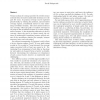Free Online Productivity Tools
i2Speak
i2Symbol
i2OCR
iTex2Img
iWeb2Print
iWeb2Shot
i2Type
iPdf2Split
iPdf2Merge
i2Bopomofo
i2Arabic
i2Style
i2Image
i2PDF
iLatex2Rtf
Sci2ools
CCCG
2010
2010
Determining the robustness of sensor barriers
Various notions of coverage provided by wireless sensor networks have attracted considerable attention over the past few years. In general, coverage can be expressed geometrically, by relating the positions, and associated coverage regions, of individual sensors to some underlying surveillance domain. The most natural notion is area coverage, where the goal is to achieve coverage for all points in the surveillance domain by a static arrangement of sensors. A less demanding alternative is barrier coverage, where the goal is to ensure merely the absence of undetectable transitions between critical subsets of the surveillance domain (for example, between unsecured entry and exit points). An arbitrary arrangement A of sensors is said to form a barrier between regions S and T if every path joining a point in S to a point in T must intersect the coverage region associated with at least one sensor in A. Determining if an arrangement of unit disks in the plane (or unit spheres in 3-space) for...
| Added | 10 Feb 2011 |
| Updated | 10 Feb 2011 |
| Type | Journal |
| Year | 2010 |
| Where | CCCG |
| Authors | David G. Kirkpatrick |
Comments (0)

